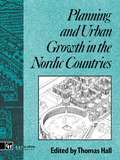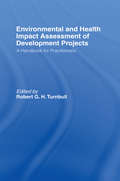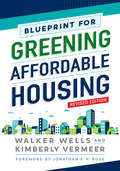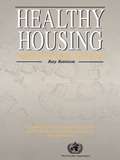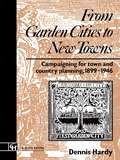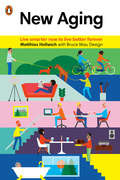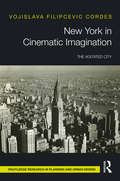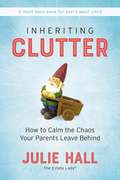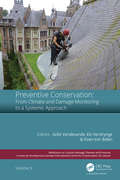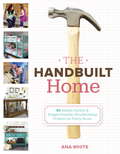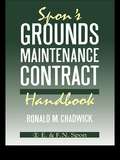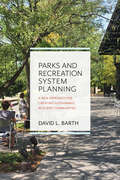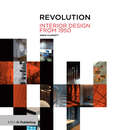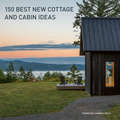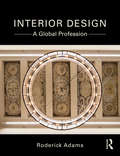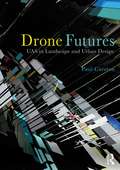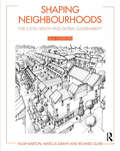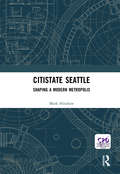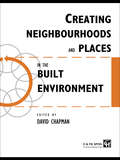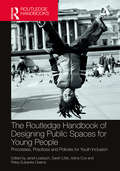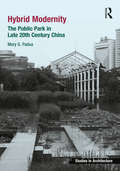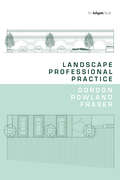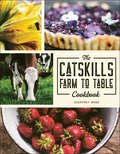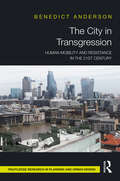- Table View
- List View
Planning and Urban Growth in Nordic Countries (Planning, History and Environment Series)
by Thomas HallPlanning and Urban Growth in Nordic Countries examines urban development and planning in Denmark, Finland, Norway and Sweden. Emphasis is on the period from the mid-nineteenth century to the present day, and the authors of each 'country-study' look at their own national developments against the background of those in other Nordic countries well as the rest of Europe and the USA.
Environmental and Health Impact Assessment of Development Projects: A handbook for practitioners
by The World Health OrganizationThis handbook for practitioners in environmental and public health, environmental management, toxicology and ecotoxicology has been prepared by an international group of experts from both developing and developed countries and covers a wide range of topics in both environmental impact assessment and environmental health impact assessment.
Blueprint for Greening Affordable Housing, Revised Edition
by Walker Wells Kimberly VermeerBlueprint for Greening Affordable Housing is the most comprehensive resource on how green building principles can be incorporated into affordable housing design, construction, and operation. In this fully revised edition, Walker Wells and Kimberly Vermeer capture the rapid evolution of green building practices and make a compelling case for integrating green building in affordable housing. The Blueprint offers guidance on innovative practices, green building certifications for affordable housing, and the latest financing strategies. The completely new case studies share detailed insights on how the many elements of a green building are incorporated into different housing types and locations. Every affordable housing project can achieve the fundamentals of good green building design. The Blueprint gives project teams what they need to push for excellence.
Healthy Housing: A practical guide
by Ray RansonThe objective of this book is to encourage administrations to formulate a sound housing policy to solve basic health-related housing problems and to meet WHO's objective of healthful housing for all by the year 2000. The principles of healthy housing have universal applicability, as most countries of the developed world have areas of slum or otherwise insanitary housing.It is hoped that this guide will be used extensively as a reference to basic health requirements for new housing and human settlements and as a guide for assessing the hygienic quality of existing housing. The book would sit well alongside inter-professional and community education programmes.
From Garden Cities to New Towns: Campaigning for Town and Country Planning 1899-1946 (Planning, History and Environment Series #Vol. 13)
by Dennis HardyThis book offers a detailed record of one of the world's oldest environmental pressure groups. It raises questions about the capacity of pressure groups to influence policy; and finally it assesses the campaing as a major factor in the emergence of modern town and planning, and as a backdrop against which to examine current issues.
Modern Housing (Metropolitan America Ser.)
by Catherine BauerThe original guide on modern housing from the premier expert and activist in the public housing movement Originally published in 1934, Modern Housing is widely acknowledged as one of the most important books on housing of the twentieth century, introducing the latest developments in European modernist housing to an American audience. It is also a manifesto: America needs to draw on Europe&’s example to solve its housing crisis. Only when housing is transformed into a planned, public amenity will it truly be modern. Modern Housing&’s sharp message catalyzed an intense period of housing activism in the United States, resulting in the Housing Act of 1937, which Catherine Bauer coauthored. But these reforms never went far enough: so long as housing remained the subject of capitalist speculation, Bauer knew the housing problem would remain. In light of today&’s affordable housing emergency, her prescriptions for how to achieve humane and dignified modern housing remain as instructive and urgent as ever.
New Aging: Live Smarter Now to Live Better Forever
by Matthias Hollwich Bruce Mau DesignAging is a gift that we receive with life--and in New Aging, the architect Matthias Hollwich outlines smart, simple ideas to help us experience it that way. New Aging invites us to take everything we associate with aging--the loss of freedom and vitality, the cold and sterile nursing homes, the boredom--and throw it out the window. As an architect, Matthias Hollwich is devoted to finding ways in which we can shape our living spaces and communities to make aging a graceful and fulfilling aspect of our lives. Now he has distilled his research into a collection of simple, visionary principles--brought to life with bright, colorful illustrations--that will inspire you to think creatively about how you can change your habits and environments to suit your evolving needs as you age. With advice ranging from practical design tips for making your home safer and more comfortable to thought-provoking ideas on how we work, relax, and interact with our neighbors, and even how we eat, New Aging will inspire you and your loved ones to live smarter today so you can live better tomorrow.From the Trade Paperback edition.
New York in Cinematic Imagination: The Agitated City
by Vojislava Filipcevic CordesNew York in Cinematic Imagination is an interdisciplinary study into urbanism and cinematic representations of the American metropolis in the twentieth century. It contextualizes spatial transformations and discourse about New York during the Great Depression and the Second World War, examining both imaginary narratives and documentary images of the city in film. The book argues that alternating endorsements and critiques of the 1920s machine age city are replaced in films of the 1930s and 1940s by a new critical theory of "agitated urban modernity" articulated against the backdrop of turbulent economic and social settings and the initial practices of urban renewal in the post-war period. Written for postgraduates and researchers in the fields of film, history and urban studies, with 40 black and white illustrations to work alongside the text, this book is an engaging study into cinematic representations of New York City.
Inheriting Clutter: How to Calm the Chaos Your Parents Leave Behind
by Julie HallEveryday hundreds of adult children become middle-aged orphans when their elderly parents pass away, leaving behind more than just memories.You&’ve heard the horror stories: arguments over stuff, an inheritance lost forever when easily deceived parents are scammed, siblings estranged, an adult heir taken from daily responsibilities for months because of the enormous task of clearing out a childhood home. It doesn&’t have to be that way.The Estate Lady, professional estate liquidator Julie Hall, knows what to do. Whether your parents are still living or you&’re caught in the middle of a crisis, Inheriting Clutter: How to Calm the Chaos Your Parents Leave Behind has solutions. Hall provides trustworthy counsel on how to:Divide your parents&’ estate with peace of mindMinimize fighting with siblings during the estate settlement processClear out the family home in thirty days or lessIdentify potential items of value in the homeHave &“that conversation&” with your parentsPrepare your own children for the futureThe Estate Lady offers guidance for any executor, heir, or beneficiary, sharing some of her most fascinating stories as well as helpful checklists of the things that need to be done now and at the time of your loss.Inheriting Clutter gives you practical, effective steps for liquidating and distributing your parents&’ assets in a way that both honors them and promotes family harmony for generations to come.
Preventive Conservation - From Climate and Damage Monitoring to a Systemic and Integrated Approach: Proceedings of the International WTA - PRECOM3OS Symposium, April 3-5, 2019, Leuven, Belgium (Reflections on Cultural Heritage Theories and Practices)
by Aziliz VandesandeThe concept of preventive conservation has successfully introduced the knowledge that "prevention is better than cure" into the built heritage sector. The benefits of this approach are the cost-effectiveness, the improved protection of heritage values, the reduced risk for accumulating deterioration and additional damage, the prolongation of the physical service life of buildings and building parts and the empowerment of local communities in dealing with heritage. Increasingly, arguments rise against reactive treatment patterns, which result too often in postponed interventions and increasing costs for restoration. WTA-Nederland-Vlaanderen, the Raymond Lemaire International Centre for Conservation and the Civil Engineering Department of KU Leuven jointly organised an international conference on preventive conservation approaches - including climate and damage monitoring - and how to implement these monitoring tools within a systemic approach. The conference took place in context of the international WTA days, 3-5 April 2019, and the 10th anniversary of the UNESCO Chair on Preventive Conservation, Monitoring and Maintenance of Monuments and Sites (PRECOM³OS). The contributions meet the increasing demand for information, case studies and practical examples to support the transition towards more preventive rather than reactive conservation actions. The volume aims at academics and professionals involved or interested in the conservation of buildings, building parts and heritage.
The Handbuilt Home: 34 Simple Stylish and Budget-Friendly Woodworking Projects for Every Room
by Ana WhiteCreate a Beautiful, Modern Home with One-of-a-Kind DIY FurnitureBeds, organizers, Adirondack chairs, a play table, and more! It's easy to build inexpensive, quality furnishings with this indispensible collection of woodworking projects from Ana White, the popular blogger who has inspired millions of homemakers with her stylish furniture plans and DIY spirit. As a young mom on a tight budget, Ana learned to make her own well-designed pieces inspired by the styles in her favorite stores--saving thousands of dollars in the process.Now, in this reference for woodworkers of all skill levels, Ana shares everything she has learned along the way. Inside The Handbuilt Home you'll find:* Plans for 34 versatile furniture projects for every room in your house--from beginner-friendly home accessories to sturdy tables, a media center, kids' items, and storage solutions* Comprehensive information on using off-the-shelf lumber and basic equipment--almost every project can be made with a drill, a saw, and some hand tools* Easy-to-follow instructions, costs, and time estimates to guide even the most amateur of carpenters through any projectYou don't need to be physically tough or superstrong to make your own furniture, and it's okay if you don't know that a 2x4 doesn't actually measure 2 by 4 inches. All you need is the determination to create a better home for yourself or your family and the confidence to say, "I can build that." Also available as an eBook
Spon's Grounds Maintenance Contract Handbook
by Mr R Chadwick R.M. ChadwickAimed at those at the sharp end of contract grounds maintenance, this book will provide guidance for anyone unfamiliar with the process of contracting work out. Written in a clear and readable style and full of practical details it will be particularly valuable to local authorities who, from 1990 will be thrown into contractual maintenance and competitive tendering for the first time.
Parks and Recreation System Planning: A New Approach for Creating Sustainable, Resilient Communities
by David BarthParks and recreation systems have evolved in remarkable ways over the past two decades. No longer just playgrounds and ballfields, parks and open spaces have become recognized as essential green infrastructure with the potential to contribute to community resiliency and sustainability. To capitalize on this potential, the parks and recreation system planning process must evolve as well. In Parks and Recreation System Planning, David Barth provides a new, step-by-step approach to creating parks systems that generate greater economic, social, and environmental benefits.Barth first advocates that parks and recreation systems should no longer be regarded as isolated facilities, but as elements of an integrated public realm. Each space should be designed to generate multiple community benefits. Next, he presents a new approach for parks and recreation planning that is integrated into community-wide issues. Chapters outline each step—evaluating existing systems, implementing a carefully crafted plan, and more—necessary for creating a successful, adaptable system. Throughout the book, he describes initiatives that are creating more resilient, sustainable, and engaging parks and recreation facilities, drawing from his experience consulting in more than 100 communities across the U.S.Parks and Recreation System Planning meets the critical need to provide an up-to-date, comprehensive approach for planning parks and recreation systems across the country. This is essential reading for every parks and recreation professional, design professional, and public official who wants their community to thrive.
Revolution: Interior Design from 1950
by Drew PlunkettThe last half of the twentieth century saw the emergence, evolution and consolidation of a distinct interior design practice and profession. This book is invaluable for students and practitioners, providing a detailed specialist, contemporary historical analysis of their profession and is beautifully illustrated, with over 200 photos and images from the 1950s through to the present day.
150 Best New Cottage and Cabin Ideas
by Francesc ZamoraCreate a cozy getaway with this fabulous compendium in the highly successful 150 Best series, packed with images, ideas, inspiration, and information on the latest trends in small space design.150 Best New Cottage and Cabin Ideas shows off a diversity of creative, and innovative getaway homes the exemplify the small-space trend. Francesc Zamora draws on the developments of distinguished international architects and designers who have worked to achieve practical, innovative, and stylish solutions adapted to the specific needs and particular tastes of their clients.Filled with hundreds of color and black-and-white photographs, this comprehensive handbook offers an extensive collection of cabins and cottages from all over the world, and provides an inspirational source of ideas for architects, designers, and homeowners alike—whether you’re looking to design and build a new dwelling or renovating and redecorating an existing structure.
Interior Design: A Global Profession
by Roderick AdamsAs the globe shrinks and the concept of distance diminishes, this text challenges the current status quo by identifying the cohesions and specialisations of design communities across the continents. It sets out an international spatial design landscape, identifying and contouring global design practice and design hotspots from a range of case studies, interviews and design practice perspectives. Using a range of interior environments, the chapters link the origins, trends and perceptions of the interior to create new insight into trans-global design. The book expands, but also coheres the interior design discipline to ensure the subject continues to grow, develop and influence the inhabitations of the world. The book features a wealth of pedagogical elements including: Beautifully designed with over 100 full colour illustrations, photographs and examples of design work Maps and diagrams which highlight hotspots of design across the globe, providing strong graphic information Interview panels featuring professional insights from designers across the globe ‘Employability’ boxes, providing a good tips guide for students gaining employment across the globe ‘International Dimension’ boxes which strengthen the scholarship of studying interior design in a globalised way ‘Design Oddities’ box which brings into focus any new or contextual facts that help contextualise the global interior.
Drone Futures: UAS in Landscape and Urban Design
by Paul CuretonDrone Futures explores new paradigms in Unmanned Aircraft Systems (UAS) in landscape and urban design. UAS or drones can be deployed with direct application to the built environment; this book explores the myriad of contemporary and future possibilities of the design medium, its aesthetic, mapping agency, AI, mobility and contribution to smart cities. Drones present innovative possibilities, operating in a ‘hover space’ between human scales of landscape observation and light aircraft providing a unique resolution of space. This book shows how UAS can be utilised to provide new perspectives on spatial layout, landscape and urban conditions, data capture for construction monitoring and simulation of design proposals. Author Paul Cureton examines both the philosophical use of these tools and practical steps for implementation by designers. Illustrated in full colour throughout, Drone Futures discusses UAS and their connectivity to other design technologies and processes, including mapping and photogrammetry, AR/VR, drone AI and drones for construction and fabrication, new mobilities, smart cities and city information models (CIMs). It is specifically geared towards professionals seeking to understand UAS applications and future development and students seeking an understanding of the role of drones and airspace in the built environment and its powerful geographic imaginary. With international contributions, multidisciplinary sources and case studies, Drone Futures examines new powers of flight for visualising, interpreting and presenting landscapes and urban spaces of tomorrow.
Shaping Neighbourhoods: For Local Health and Global Sustainability
by Hugh Barton Marcus Grant Richard GuiseThis substantially revised and important second edition comes at a pivotal time, with both a strong agenda of localism in planning and with public health professionals now realising the vital importance of shaping urban environments in order to reduce the burden of disease and support better health outcomes. This guide ensures you: understand the underlying principles for planning healthy and sustainable neighbourhoods and towns plan the collaborative and inclusive processes needed for multi-sectoral cooperation develop know-how and skills in matching local need with urban form discover new ways to integrate development with natural systems design places with character and recognise good urban form guide communities, and advise developers, in the creation of successful and sustainable places for living. Containing many new case studies and a wealth of new research, this new edition has benefited from previous user feedback. Shaping Neighbourhoods is the indispensable guide for bridging the gulf between theory and practice, between planning authorities, investors and communities, and between different professional perspectives. Whether you are a student faced with a local planning project; a planner, urban designer or developer involved in new development; a health authority concerned with promoting physical activity; or a community group wanting to improve your neighbourhood; this book is for you.
Citistate Seattle: Shaping A Modern Metropolis
by Mark HinshawWith style and humor, the author writes of special places in everyday Seattle. The author takes us to popular, high-profile landmarks like Pike Place Market as well as tucked-away gems — cozy cottages, trendy pubs, gracious apartment buildings, and vibrant urban villages — that flavor and enliven the city. The author shares his eye for unique, humanizing details of design, architecture, and function, bringing this colorful metropolis to life so vividly you'll practically smell the coffee they brew and sell on (almost) every street corner. Along the way, the author explains the public and private decisions that helped Seattle avoid the urban desolation that plagues other American cities. The author introduces many of Seattle's movers and shakers — mayors, developers, artists, and urban pioneers — who took it upon themselves to guide metropolitan Seattle along a different path.
Creating Neighbourhoods and Places in the Built Environment (Built Environment Series Of Textbooks Ser.)
by David ChapmanThis design primer examines the forces at work in the built environment and their impact on the form of buildings and their environments. The actions of a range of individuals and agencies and the interaction between them is examined, exploring the competing interests which exist, their interaction with physical and environmental forces and the uncertain results of both individual and corporate intervention.
The Routledge Handbook of Designing Public Spaces for Young People: Processes, Practices and Policies for Youth Inclusion
by Janet Loebach Sarah Little Adina Cox Patsy Eubanks OwensThe Routledge Handbook of Designing Public Spaces for Young People is a thorough and practical resource for all who wish to influence policy and design decisions in order to increase young people’s access to and use of public spaces, as well as their role in design and decision-making processes. The ability of youth to freely enjoy public spaces, and to develop a sense of belonging and attachment to these environments, is critical for their physical, social, cognitive, and emotional development. Young people represent a vital citizen group with legitimate rights to occupy and shape their public environments, yet they are often driven out of public places by adult users, restrictive bylaws, or hostile designs. It is also important that children and youth have the opportunity to genuinely participate in the planning of public spaces, and to have their needs considered in the design of the public realm. This book provides both evidence and tools to help effectively advocate for more youth-inclusive public environments, as well as integrate youth directly into both research and design processes related to the public realm. It is essential reading for researchers, design and planning professionals, community leaders, and youth advocates.
Hybrid Modernity: The Public Park in Late 20th Century China (Ashgate Studies in Architecture)
by Mary G. PaduaThis book provides a detailed historical and design analysis of the development of parks and modern landscape architecture in late 20th century China. It questions whether the fusion of international influences with the local Chinese design vocabulary in late 20th century China has created a distinctive and novel approach to the design of public parks. Hybrid Modernity proposes a new theory for examining the design of public parks built in post-Mao China since the reforms and sets the various processes for China’s late 20th century socio-cultural context. Drawing on modernization theory, research on China’s modernity, local and global cultural trends, it illustrates through a range of case studies ways hybrid modernity defines a new design genre and language for the spatial forms of parks that emerged in China’s secondary cities. Featured case studies include the Living Water Park in Chengdu, Sichuan province, Zhongshan Shipyard Park in Guangdong Province, Jinji Lake Landscape Master Plan in Suzhou, Jiangsu province, and the West Lake Southern Scenic Area Master Plan in Hangzhou, Zhejiang province. This book argues that these forms represent a new stage in China’s history of landscape architecture. The work reveals that as a new profession, landscape architecture has greatly contributed to China’s massive urban experiment. This book is an ideal read for students enrolled in landscape architecture, architecture, fine arts and urban planning programs who are engaged in learning the arts and international design education.
Landscape Professional Practice
by Gordon Rowland FraserGraduate of the Royal Botanic Gardens, Kew, Chartered Landscape Architect, MBA and Barrister, Gordon Rowland Fraser draws upon 30 years of project management, professional practice and teaching experience to provide an uncomplicated and intuitive guide to the business aspects of the landscape profession. An indispensable reference for seasoned professionals, the book will enable the student or novice practitioner to turn their drawing board inspiration into reality without being overwhelmed or afraid of overseeing the implementation of their proposals. Guided by the Landscape Institute’s 2013 Pathway to Chartership syllabus, this structured, step-by-step, narrative guide sets out the documentation commonly used within the landscape profession and makes accessible a logical and sequential understanding of contractual relationships; procurement strategies; processes of preparing client estimates and obtaining competitive quotations; of preparing contract documentation and administering formal contracts; general concepts of law as they relate to land management and the landscape profession; of business administration, market appraisal and positioning; and of the landscape consultant’s appointment. As an understanding of professional practice is intrinsic to all Landscape Institute accredited courses, this is an essential text for every landscape architecture student during their education and their subsequent journey into professional practice. Those undertaking Garden Design Diplomas will similarly find the book invaluable as they venture into the world of creativity and commerce, while the seasoned practitioner will find it a comprehensive point of reference to add to their bookshelf.
The Catskills Farm to Table Cookbook: Over 75 Recipes
by Courtney WadeFeatures delicious recipes and breathtaking photography which will take you on a journey of upstate New York.Fresh vegetables and fruit, meat, dairy, wild game and foraged produce all take center stage in The Catskills Farm to Table Cookbook--because that is what eating in the Catskills is all about! Farms and restaurants emphasizing the use of local foods and produce are also highlighted, creating a guide to the farm to table movement in the region. Knowing what goes into the food on your plate is not just a trend--it's an understanding of the processes, the time, the individuals, the community, and the lifestyle behind it all. With its down-to-earth recipes and full-color images, let The Catskills Farm to Table Cookbook be your essential guide.
The City in Transgression: Human Mobility and Resistance in the 21st Century
by Benedict AndersonThe City in Transgression explores the unacknowledged, neglected, and ill-defined spaces of the built environment and their transition into places of resistance and residence by refugees, asylum seekers, migrants, the homeless, and the disadvantaged. The book draws on urban and spatial theory, socio-economic factors, public space, and architecture to offer an intimate look at how urban sites and infrastructure are transformed into spaces for occupation. Anderson proposes that the varied innovations and adaptations of urban spaces enacted by such marginalized figures – for whom there are no other options – herald a radical new spatial programming of cities. The book explores cities and sites such as Mexico City and London, the Mexican/US border, the Calais Jungle, and Palestinian camps in Beirut and utilizes concepts associated with ‘mobility’ – such as anarchy, vagrancy, and transgression – alongside photography, 3D modelling, and 2D imagery. From this constellation of materials and analysis, a radical spatial picture of the city in transgression emerges. By focusing on the ‘underside of urbanism’, The City in Transgression reveals the potential for new spatial networks that can cultivate the potential for self-organization so as to counter the existing dominant urban models of capital and property and to confront some of the major issues facing cities amid an age of global human mobility. This book is valuable reading for those interested in architectural theory, modern history, human geography and mobility, climate change, urban design, and transformation.
